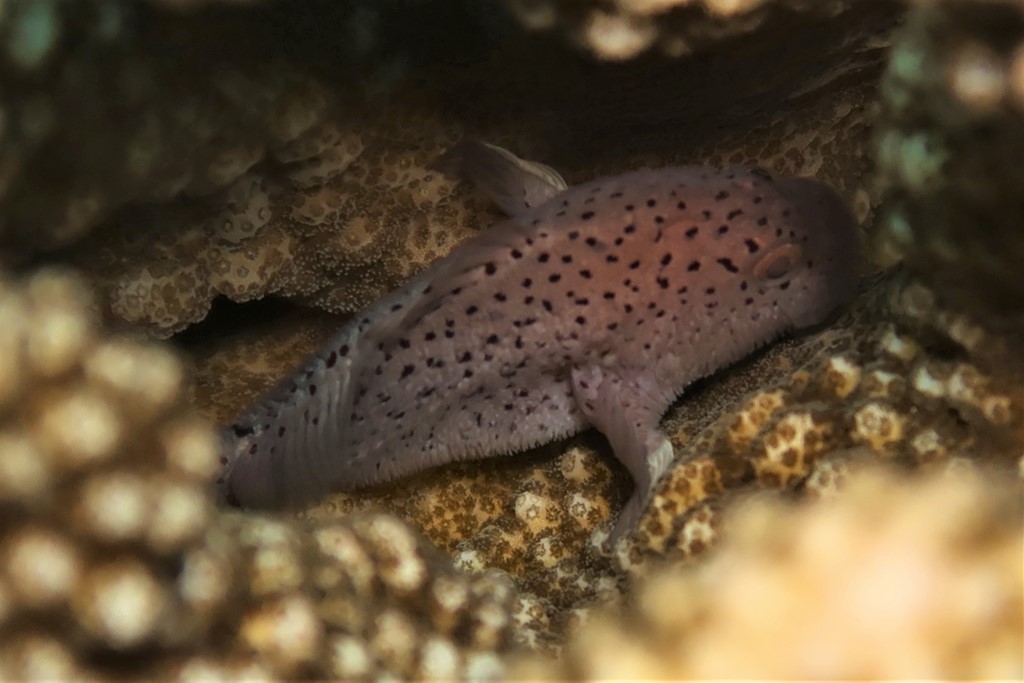CARACANTHUS MACULATUS - (GRAY, 1831)
Picture courtesy of: Alain Daoulas
Actinopterygii (Gigaclass) > Actinopteri (Class) > Teleostei (Subclass) > Perciformes (Order) > Scorpaenoidei (Suborder) > Scorpaenidae (Family) > Caracanthinae (Subfamily) > Caracanthus (Genus)
Poisson-velours à taches écarlates, Spotted croucher, Spotted coral croucher, Scarlet-spotted velvetfish, Dango-okoze, ダンゴオコゼ, 斑点头棘鲉, 斑點棘頰鮋,
Synonyme
Micropus maculatus (Gray, 1831)
--------------------------
Description
Dorsal spines (total): 6-8; Dorsal soft rays (total): 12-13; Anal spines: 2; Anal soft rays: 11-14; Pectoral fin rays: 13-14; Depth of body about: 1.7 in SL. Body covered in tiny tubercles; Dorsal fin notched; Single small spine at lower anterior edge of lacrimal. Max. length: 5.0 cm TL. Depth range: 3 - 30 m.
Color
Body tan to light gray covered with numerous small reddish-brown spots and has a notched dorsal fin.
Etymology
Caracanthus: from ancient Greek, kára = head + from Greek, acanthus = thorn or spine. Referring to infraorbital of Caracanthus typicus armed with strong spines.
maculatus: from Latin, maculatus = stain, make spotted. Referring to yellow-red spots on sides, back and top of head.
Original description: Micropus maculatus Gray, 1831 - Type locality: Hao Island, Tuamotu Islands, French Polynesia.
Distribution
Eastern Indian Ocean, western Pacific: Christmas and Cocos-Keeling islands and Indonesia, east to Marshall and Tuamotu islands, north to Ryukyu Islands and Amami Islands (southern Japan), south to Queensland (Australia) and New Caledonia.
Actinopterygii (Gigaclass) > Actinopteri (Class) > Teleostei (Subclass) > Perciformes (Order) > Scorpaenoidei (Suborder) > Scorpaenidae (Family) > Caracanthinae (Subfamily) > Caracanthus (Genus)
Poisson-velours à taches écarlates, Spotted croucher, Spotted coral croucher, Scarlet-spotted velvetfish, Dango-okoze, ダンゴオコゼ, 斑点头棘鲉, 斑點棘頰鮋,
Synonyme
Micropus maculatus (Gray, 1831)
--------------------------
Description
Dorsal spines (total): 6-8; Dorsal soft rays (total): 12-13; Anal spines: 2; Anal soft rays: 11-14; Pectoral fin rays: 13-14; Depth of body about: 1.7 in SL. Body covered in tiny tubercles; Dorsal fin notched; Single small spine at lower anterior edge of lacrimal. Max. length: 5.0 cm TL. Depth range: 3 - 30 m.
Color
Body tan to light gray covered with numerous small reddish-brown spots and has a notched dorsal fin.
Etymology
Caracanthus: from ancient Greek, kára = head + from Greek, acanthus = thorn or spine. Referring to infraorbital of Caracanthus typicus armed with strong spines.
maculatus: from Latin, maculatus = stain, make spotted. Referring to yellow-red spots on sides, back and top of head.
Original description: Micropus maculatus Gray, 1831 - Type locality: Hao Island, Tuamotu Islands, French Polynesia.
Distribution
Eastern Indian Ocean, western Pacific: Christmas and Cocos-Keeling islands and Indonesia, east to Marshall and Tuamotu islands, north to Ryukyu Islands and Amami Islands (southern Japan), south to Queensland (Australia) and New Caledonia.
Biology
Inhabits shallow reef crests, usually exposed to moderate surge. Common among the branches of pocilloporid corals and some species of Acropora. Feeds on coral dwelling fishes and crustaceans. Occasionally traded in the aquarium industry. Venomous spines. They are protogynous hermaphrodites, with individuals changing sex from male to female during their life cycle.
Inhabits shallow reef crests, usually exposed to moderate surge. Common among the branches of pocilloporid corals and some species of Acropora. Feeds on coral dwelling fishes and crustaceans. Occasionally traded in the aquarium industry. Venomous spines. They are protogynous hermaphrodites, with individuals changing sex from male to female during their life cycle.
Similar species
Caracanthus unipinna (Gray, 1831) - Reported from New Caledonia. Caracanthus unipinna, is uniformly brown to greyish-brown in color and lacks a deep notch between the spinous and soft-rayed parts of the dorsal fin.
Last update: 21, July 2024
